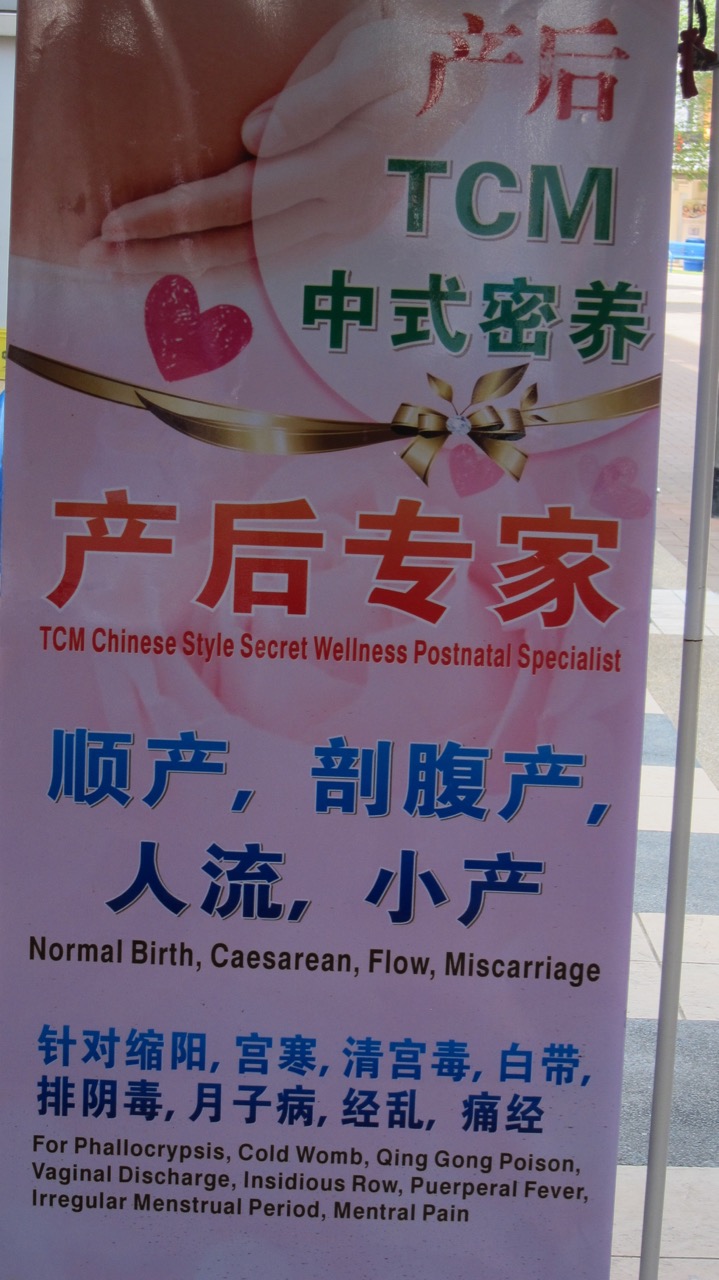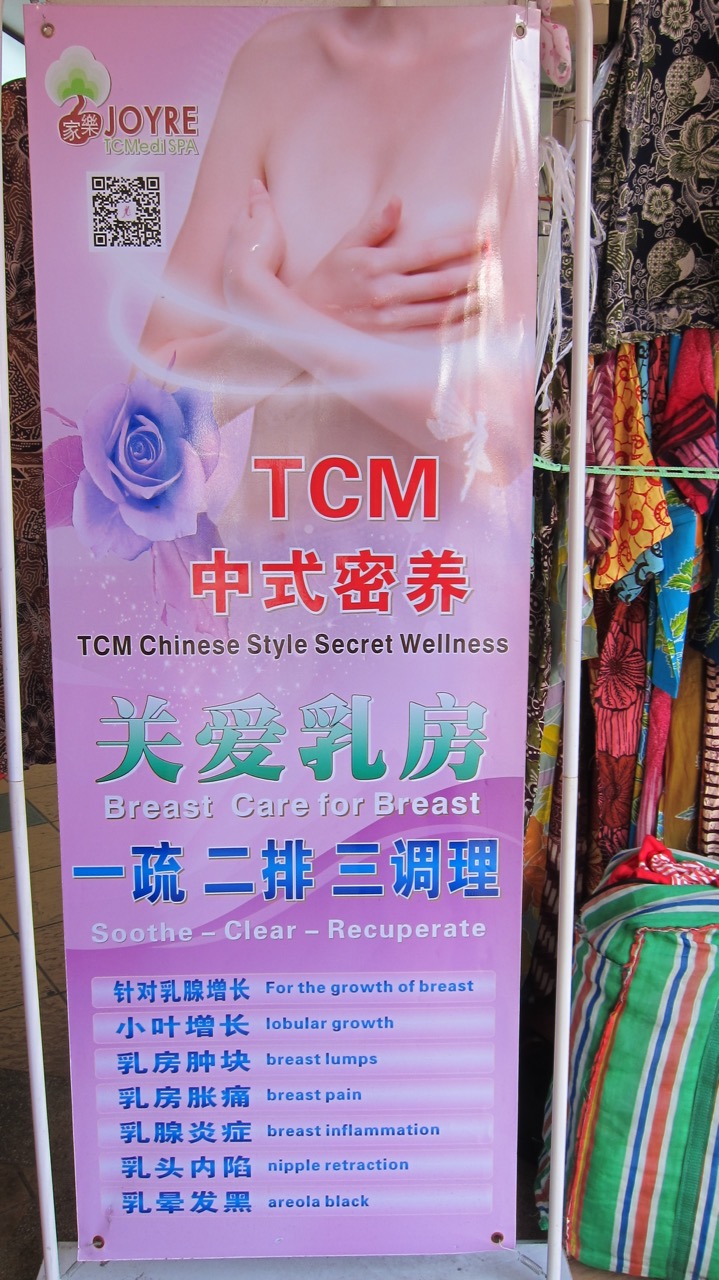TCM approach to women's wellness
« previous post | next post »
[N.B.: TCM stands for "Traditional Chinese medicine"]
Geok Hoon (Janet) Williams found these posters this morning at Clementi, Singapore:
There is much that could be said about the wording on the first poster, but I shall concentrate only on one term that stands out: "Flow". No, that is not a reference to a regular commenter on Language Log. It is the misrendering of Chinese rénliú 人流, and it comes directly from Google Translate or Bing Translator, but not Baidu Fanyi, which yields the equally inappropriate "stream of people". "Rénliú 人流" (lit., "human flow") is short for réngōng liúchǎn 人工流产 (lit., "human work miscarriage", i.e., "artificial / induced miscarriage" or simply "abortion").
By far the more common expression for "abortion" is duòtāi 堕胎 (lit., "fall / drop / send down fetus") (15,800,000 ghits), vs. réngōng liúchǎn 人工流产 (416,000 ghits).
If they could get "phallocrypsis" (for suōyīn 缩阴 ["vaginal contraction"] — Baidu Fanyi gives "Wahaha", the name of China's largest beverage producer!) right, surely they ought to have been able to handle "abortion" — unless they were being squeamish. Wait a minute! Don't be too impressed with a big medical term like "phallocrypsis"! They really messed up with suōyīn 缩阴 too, because phallocrypsis means "dislocation and retraction of the penis, so that it is almost invisible", and that definitely doesn't apply to women! Phallocrypsis would be a suitable translation for suōyáng 缩阳 ("penile contraction").
Moving on to the next poster:
Some of the translations on this sign are surprisingly felicitous, such as "Soothe" for shū 疏 ("sparse; thin; scattered; nondense"). Believe it or not, however, there is actually a category of dense versus nondense in mammography. Nonetheless, I do not find any really gross errors on this poster, though I should mention, in order to enhance understanding of the last item, that Chinese women really do not like it when the area around their nipples becomes very dark.
What I would like to focus on here is the, er, flagrant redundancy of the English translation for the main announcement of services offered by this TCM clinic in big green characters: "Breast Care for Breast". Just looking at the English, I thought that perhaps the first "Breast" was a typo for "Best". Then, when I started to pay more attention to just what the corresponding Chinese was saying, I realized that the redundancy must have been triggered by some other source.
Here's what the Chinese says:
guān'ài rǔfáng 关爱乳房
("loving care for the breast", which we could also rephrase more simply as "breast care")
Baidu Fanyi has "care breast" and Bing Translator gives "love breasts", but Google Translate nails it with "breast care". What the poster maker seems to have done is take the Google Translate rendering of the whole four character expression for just the first two characters and then repeated the word "breast" for the last two characters after that.
Such are the perils of relying on machines for our translations, even when they're mostly right.


Martha said,
July 28, 2016 @ 9:49 am
I'm confused by "Chinese style secret wellness." Are you visiting these people in secret, or do they have secret remedies, known only to them?
leoboiko said,
July 28, 2016 @ 11:30 am
A graphological curiosity: the original structure of the character 流 is well-suited for this purpose.
Liúchǎn 流产 suggests something like "flush the birth"; liú is glossed on CEDICT as "to flow; to spread; stream of water; grade; to banish or send into exile", etc. So, in the modern language at least, it seems to have a wide range of meanings, centering on the idea of "to flow" or "to flush away". As far as I can tell, the modern morpheme isn't centered on "abortion".
The character used to represent this morpheme, 流, includes "water" 氵 and "river" 川, which seems logical enough. Perhaps surprisingly, the top-right component, , depicts…an upside-down baby 子. (If you can't quite see it, try the old Seal versions: it's clearly a baby thrown in the water).
Did liú originally have stronger connotations of "abortion" or "infanticide”, (admittedly, something fairly common in premodern societies), for the representative character to be built like this? Or was there some phonetic logic, a rebus, now lost (or at least, which I fail to see)? I have no idea.
The character for qì "to discard; to abandon", 棄, is of the same family. The modern form has "tree" 木 at the bottom, but that's a graphical abbreviation; originally it was the upside-down baby above a pair of hands (see), and some unknown object which might be a basket or other container.
leoboiko said,
July 28, 2016 @ 11:35 am
(By the way, it seems like the comment software is eating the baby… I mean the Unicode character U+20AD3, which represents the top-right component of 流 as a stand-alone glyph. This is probably because the Unicode character is outside the Basic Multilingual Plane of Unicode, and the blog system doesn't support those properly. Please imagine the component in the appropriate places of my comment above.)
Lupus753 said,
July 28, 2016 @ 1:44 pm
When I saw the photo, I assumed that "flow" was a euphemism/mistranslation for menstruation. In hindsight, the fact that "flow" is surrounded by different types of births should've been a tip-off.
Hill Gates said,
July 28, 2016 @ 1:49 pm
When I did fieldwork with elderly women in Sichuan villages with the assistance of provincial Women's Fed cadres, we used "liu chan" among ourselves to mean miscarriage, but used duo tai with our subjects–a term that covered abortion and miscarriage. A question of style register in that situation, I think.
Bathrobe said,
July 28, 2016 @ 4:20 pm
'Insidious Row' struck me. My first reading was that of an 'insidious argument', but looking at the Chinese, it's clear that 排阴毒 is actually 排 pái, meaning 'row' (as in lined up in a row) and 阴毒 yīndú meaning 'insidious' or 'malice' (literally 'hidden poison').
Looking around, there doesn't appear to be a proper English term for 排阴毒. 阴 yīn is the feminine element in yin-yang, and 阴道 yīndào ('yin road') refers to the vaginal canal in Chinese. Judging from the components of the term, the actual meaning is therefore 'expel vaginal toxin'. There is a patent at Suppository for eliminating vagina diseases where the abstract refers to the 'expelling of yin toxin'. However, the body of the patent, which is said to be 'translated from Chinese' (obviously via machine translation), uses 'insidious row'. TCM is a minefield for translation (and, conversely, a wonderful area for the creative translator) because most of the terminology lacks standard or accepted English equivalents.
liuyao said,
July 29, 2016 @ 9:29 am
人流 to mean stream of people is a legitimate sense of the word. It makes it harder to do a ghit analysis whether 人流 or 堕胎 is the more common word for abortion. 人流 may be a kind of euphemism, much like abortion (used to be).